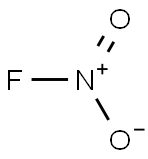Uses
Nitryl fluoride is an oxidizer in rocket propellants. It also is a fluorinating and nitrating agent in organic synthesis.
Preparation
Nitryl fluoride is obtained by reacting fluorine with nitrogen dioxide or nitric oxide:
N2O4 + F2 → 2NO2F
4NO + F2 → 2NO2F + N2
Using nitrogen dioxide provides an easier preparation than nitric oxide.
A convenient method of preparing nitryl fluoride is to heat dinitrogen tetroxide with cobalt(III) fluoride at 300°C:
N2O4 + CoF3 → 2NO2F + 2CoF2
Reactions
Nitryl fluoride is a strong oxidizing agent. Most reactions are similar to those of nitryl chloride, NO2Cl (See Nitryl Chloride Reactions). Nitryl fluoride hydrolyzes rapidly in water forming nitric acid and hydrofluoric acid:
NO2F + H2O → HNO3 + HF
Reaction with ethanol produces ethyl nitrate:
NO2F + C2H5OH → C2H5NO3 + HF
Reactions with reducing agents can be explosive. The compound attacks most metals almost as vigorously as fluorine. It spontaneously ignites boron, silicon, phosphorus, arsenic, antimony, and iodine at ordinary temperatures.
Nitryl fluoride can add a nitrate group to many organics forming their nitro derivatives:
C6H6 + NO2F → C6H5NO2 + HF
Chemical Properties
Colorless gas.Strong oxidizing agent; hydrolyzes to
form nitric and hydrogen fluoride acids.
Physical properties
Colorless gas; pungent odor; density 2.90 g/L; heavier than air, density in air 2.24 (air=1); liquefies to a colorless liquid at -63.5°C; solidifies at -139°C; decomposes in water; also decomposes in alcohol, ether and chloroform.
Uses
Oxidizer in rocket propellants; fluorinating agent.
Hazard
Ignites on contact with selenium, iodine,
phosphorus, arsenic, antimony, boron, silicon,
molybdenum. Corrosive to tissue.
Safety Profile
Poison by inhalation. A
severe irritant to skin, eyes, and mucous
membranes. A powerful oxidlzing agent.
This gas is intensely reactive. Explosive
reaction with hydrogen at 200-300°C.
Ignites on contact with antimony, arsenic,
boron, iodme, phosphorus, selenium. Ignites
when warmed with bismuth, carbon,
chromium, lead, sulfur. Incandescent
reaction with aluminum, cadmium, cobalt,
iron, molybdenum, nickel, potassium,
sodium, thorium, titanium, tungsten, uran uranium,
vanadlum, zinc, zirconium, lithium (at
200-300°C), manganese (at 200-300°C).
Incompatible with metals, nonmetals. When
heated to decomposition it emits toxic
fumes of Fand NOx. See also
FLUORIDES.

